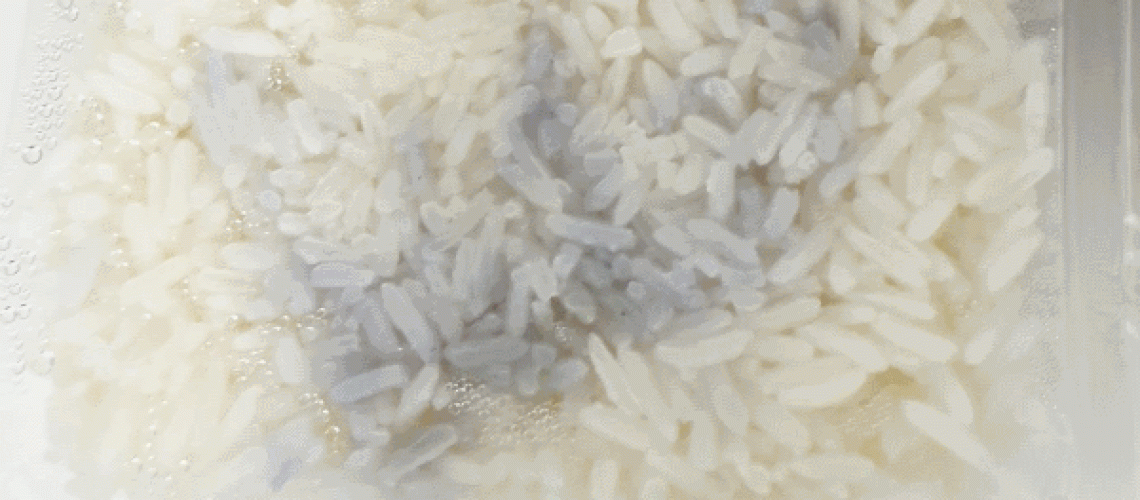YUCK - my rice has streaks in it
Three weeks ago we discovered dark spots throughout a ready-to-eat curry we had purchased from a supermarket. The product was still well within the use-by date and we were horrified.
We went to the supermarket and then discovered the same problem also existed with their current stock (as well as some very bad packaging issues, but that’s still an ongoing saga).
This week we discovered the same problem in the curry from another supermarket. (Chances are they are from the same manufacturer).
I assume that most consumers are like us, if there is strong discolouration in your food, you toss it. You can see by the photo, we aren’t talking about a little bit.
So when we say “blue rice” we don’t mean artificially coloured rice, but something more like “blue cheese”. It’s meant to be one colour but there’s something growing in it and turning it blue/grey.
We think we know the cause - Chromobacterium subtsugae
We haven’t heard back from the super markets yet, but we think we have tracked down the cause. This is all guessing on our behalf, with some helpful tips from others in the industry.
The culprit may be “chromobacterium subtsugae” – a bacteria that is used overseas as a pesticide.
One of the characteristics of chrombacterium substsugae is that it develops violet-pigmented colonies due to the production of “violecein”. The scientists coming up with these names must have been having a great laugh when they came up with that name. The end result, however, is that when it’s in your rice, it will turn your rice blue.
Is it safe?
This is where Google suddenly becomes a bit too silent. The problem is that this bacteria has only been in use for a couple of years. As far as we can tell, it’s not allowed to be used in Australia. Most of the papers online are about how effective it is against various pests. There’s currently not much being said about how safe it is.
Actually, given the nature of the internet I could make a sweeping statement here and chances are it will be accepted as fact.
So I will be up front – I don’t know.
Someone told me it was safe, and we are importing rice with it present. There are no bans for it.
Would I eat it?
That’s easy – no.
It’s indicating that bacteria is running rampant in the rice. That’s a problem.
This is new bacteria which is being injected into our diet without our consent. We have no idea what the long term consequences are.
And how can I tell if the discolouration is due to chromobacterium subtsugae or something really bad.
Is it potentially good?
This is a natural bacteria which kills pests. That’s possibly a much better solution than using chemicals to nuke our crops with. That’s possibly a great thing.
And you could argue that it is a built-in bacteria indicator. There’s an interesting marketing angle!
It may also be totally harmless, in which case it’s pest killing features are great.
Is it potentially bad?
Living in Australia, I was raised on the stories of biological solutions to problems going horribly wrong. You just have to think of the cane toad to see the catastrophic impact from one person’s stupid decision.
Using bacteria to control pests is an interesting idea and there’s a lot about it online. But how can you contain it to a field? Also an insect is a pest in one place and an endangered species in another. What about the humble bee slowly being wiped out by goodness knows what.
But for now it isn’t used in Australia, and that brings me to my next point…
Why aren't we buying Australian?
Given that we originally bought the product from a supermarket that prides itself in supporting local farmers where possible, why are they using overseas rice in these dishes instead of Australian rice?
The answer is probably very simple – price.
Imported rice is cheaper than Aussie rice, and when you are trying to sell a curry plus rice for $5, every cent matters.
But it may not be just a budget question anymore.
Will consumers accept it?
I predict that this will become a significant problem for supermarkets over the next couple of years.
I don’t think consumers will be ready to accept rice that discolours after a couple of days. They can say what they like about it being safe to eat, but it goes against everything I’ve been taught about food safety.
We have already changed supermarkets because of it, and having now seen it at two supermarkets, we are steering away from that type of meal totally.
We would rather pay a couple of dollars more for fresh food then trust blue rice.
But we may be wrong. Would you eat blue rice?
